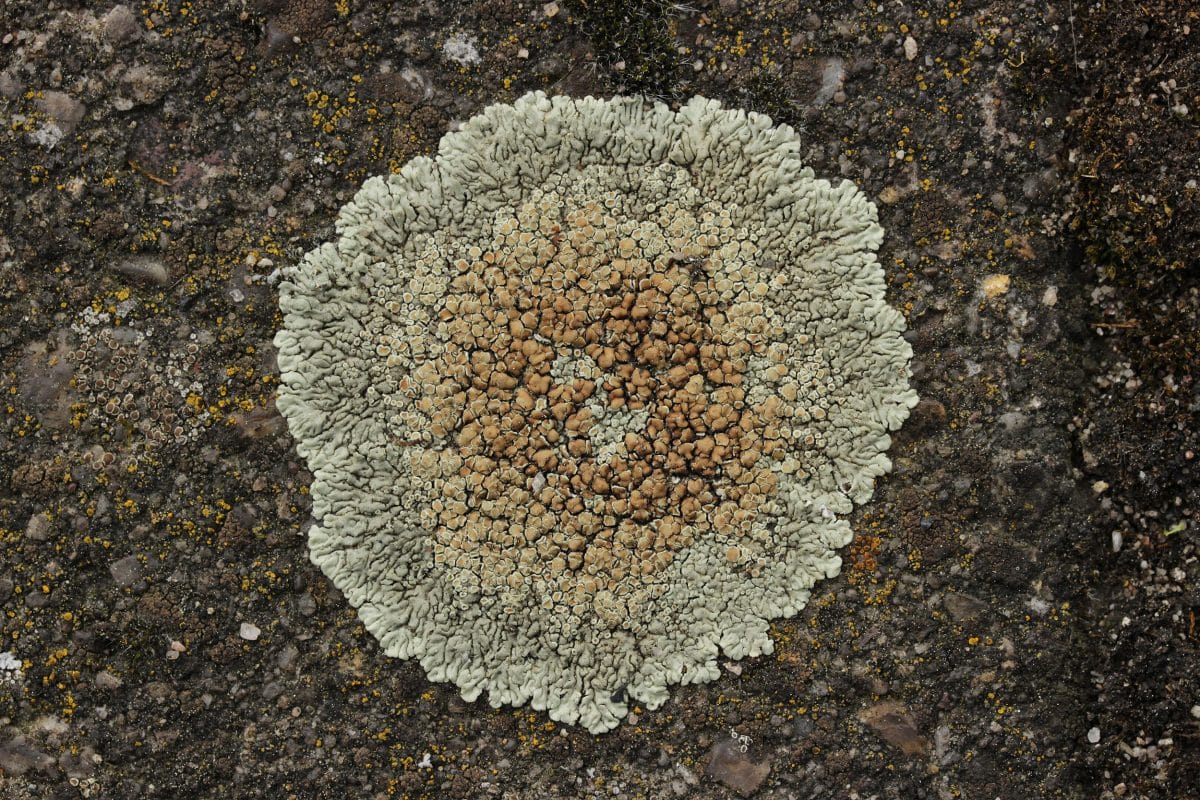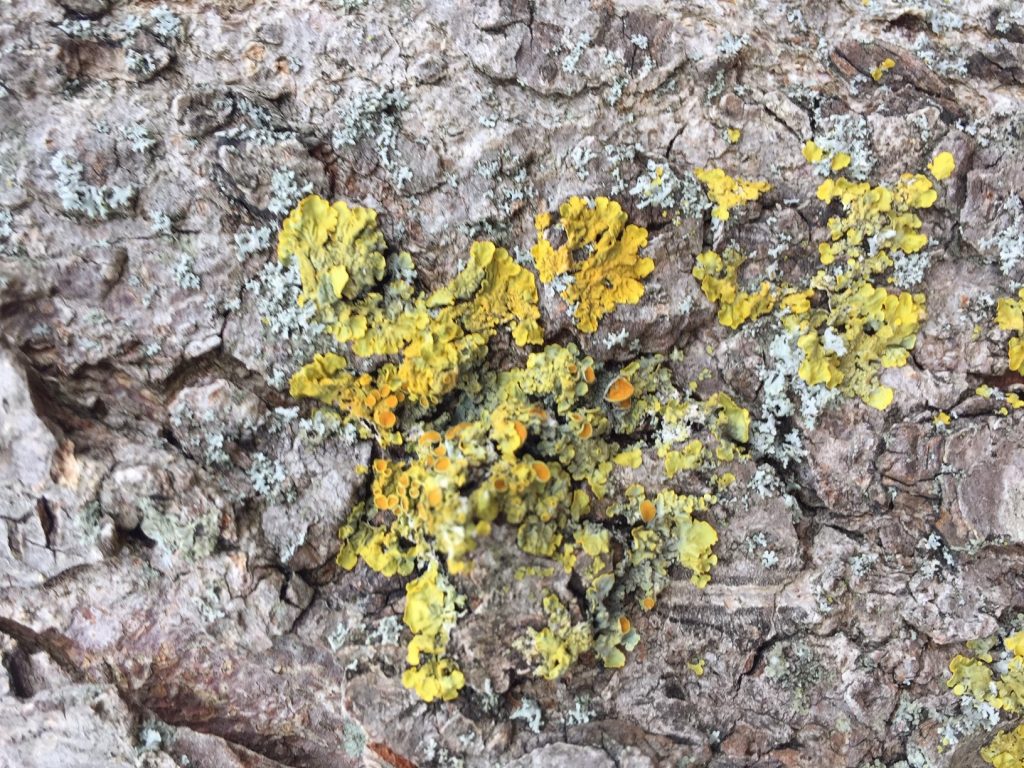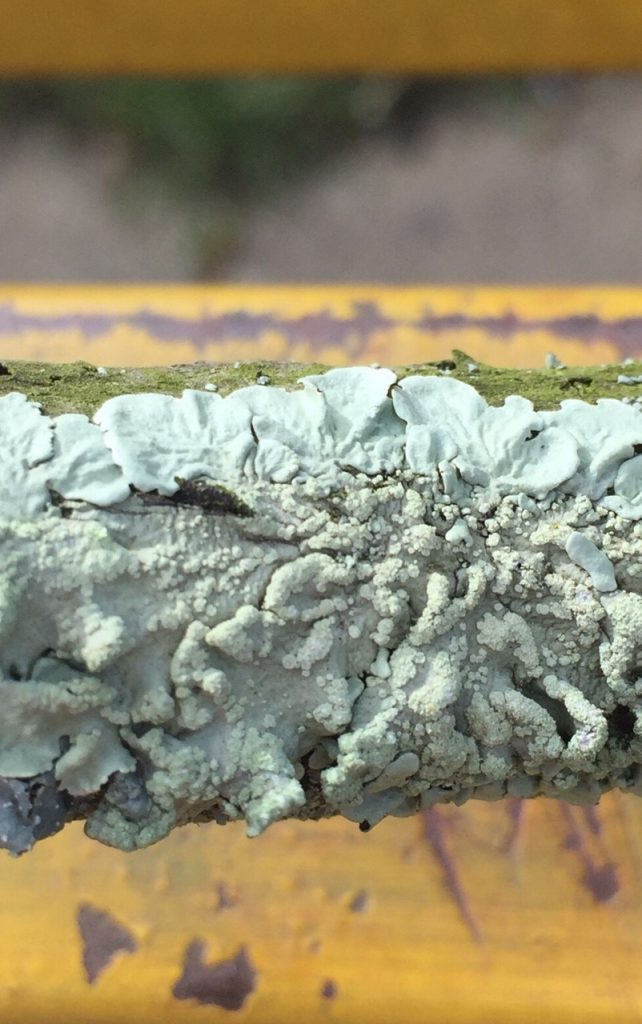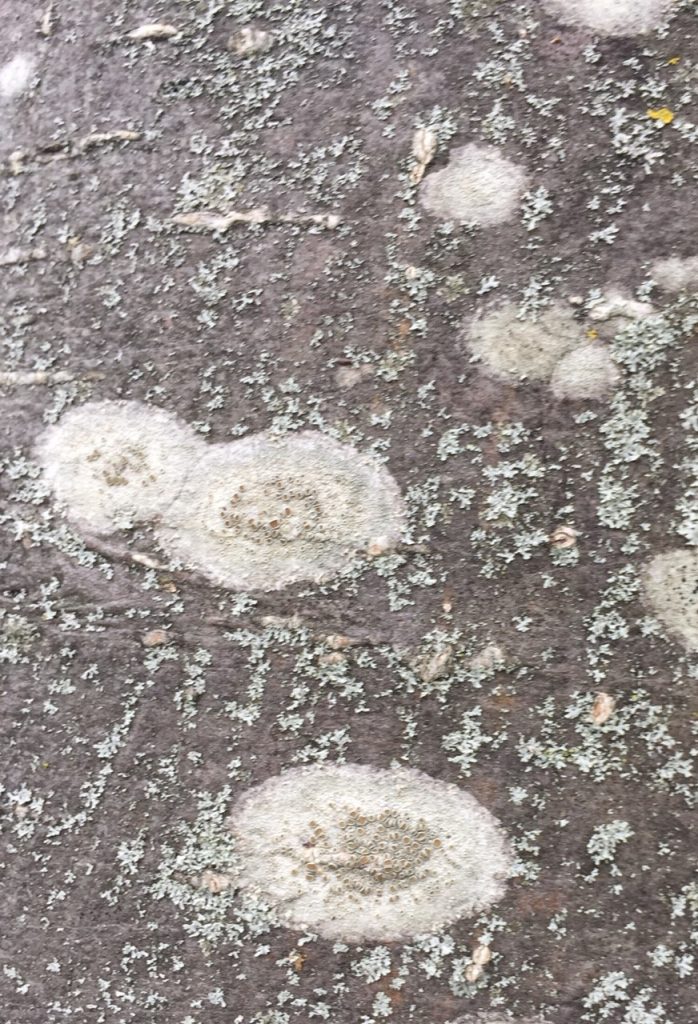Most life is small. If you look straight ahead focused on the middle-distance, the only living things you see will be humans and trees. It’s better to look down when looking for nature. Even when you are walking along the pavement.
At first, you may just see cigarette butts, beer cans, and some chewing gum on the paving slabs. But wait a second. Take a closer look at that chewing gum, with a magnifying glass if you’ve got one. Does it have bumps and ridges, and things which look like miniature brown jam tarts? Yes? Then it’s not chewing gum, it’s lichen!
Lichens are everywhere. The blotches you see on steps and walls are lichen. They are the orange crusts on trees. In the clean air of the west of England, they hang in beardy strands from branches. But in London, a lot of them will look like chewing gum on pavements and walls.
A lichen is an odd organism. It isn’t even really an organism, it’s a combination of at least two different species.

One is always a fungus, and one will either be algae, or a type of bacteria called cyanobacteria. Algae (the organisms which form the green mould on fences and make pond water green), and cyanobacteria, both create sugar from sunlight (like plants). Fungi cannot do this, so when in a lichen, fungi use sugar produced by their algal or cyanobacterial partners. In return, the fungi provides protection and shelter.
So, lichens are a combination of a fungus and algae or cyanobacteria. But that’s not all; there is often also a second fungus and one or more other bacteria, lurking in the fungal strands. Lichen is a team. A team in a similar way to humans being a team, because we couldn’t survive without the microbes in our gut and on our skin.
Each lichen is named after its main fungus. The fungus provides structure to the lichen, protecting and enveloping the damp, fragile algal cells. Most of what you see when you look at a lichen is fungus. The algal cells are inside, cosy and protected.
Lichens are the first pioneers on rock, their tiny strands penetrate the stone and use chemicals to dissolve and use its minerals. Stone fragments and old lichen come loose, and over years become soil. And that is how woodland, or grassland, starts.
They do so much for the planet. Lichens are food for insects, which in turn provide nutrition for birds and mammals. Their chemicals neutralise toxins in the soil. Lichens grow where trees can’t – 7% of the earth’s surface is lichen-dominated. They capture carbon from the atmosphere and are essential for a stable climate.
We need lichens, although they don’t need us. When humans have destroyed most life on the planet the lichens will shrug, keep growing, and ask themselves, ‘What was the point of humans?’
Pollution from coal and traffic fumes hurt lichens; scientists survey them as a way to assess air pollution. They are more luxuriant on our western coast, where clean damp air blows in from the Atlantic. But although the air is filthy by the South Circular, the chewing gum lichens survive.
The tough little lichen you see on the pavement is, often, Lecanora muralis. In Latin, the word lecanora means ‘beautiful bowl’ which refers to the rimmed brown jam tart-like structures in the centre of the lichen. Muralis simply means ‘wall’ (as in ‘murals’) and refers to its love of stone. It prefers horizontal surfaces, so you are more likely to find it on pavements or the tops of walls rather than the wall face.

Lecanora muralis is crustose, which means it grips tightly to whatever it is it is growing on. If you can pull it off it’s not a Lecanora.
Its roughly circular patches are greyish, with a shiny surface tinged with yellow or green, and white flattened margins. If you look at the lichen centre through a hand lens you might see a group of those ‘beautiful bowls’ – the apothecia, or fruiting bodies.
Like mushrooms (the fruiting bodies of fungi), these structures release fungal spores into the wind, hoping that by chance they will meet up with a stray strand of the right species of algae, so a new lichen can be made. The lichen can also make little capsules containing both the fungus and the algae, which migrate in the breeze with both the partners needed to form a new organism.
Nature Trail Lichens
On the Nature Trail itself look at the twigs on the ground, which have snapped off in the winds of early spring. Are they coated with a yellow or greenish-flaky crust? This is another lichen, likely to be Xanthoria parietina.

Xanthoria parietina, Daniel Harwood
This one you find not only on fallen twigs but on tree bark, walls and rocks. It is a foliose lichen, which means that it has leafy bits, and you can remove it from the surface where it is growing.
Like Lecanora muralis, it is pollution tolerant. It is a characteristic bright yellow or orange where it grows in full sunlight, but is greenish grey in the shade. One of its fungi produces a yellowy orange ‘sunscreen’ chemical to protect it from too much ultraviolet radiation. Making this chemical uses a lot of energy, so it doesn’t bother to make the sunscreen in the shade, so the fungus will stay grey. Take a look at one of those fallen twigs, and you may see that one side has yellow lichen and the other green.
There are two others I’ll show you as they are around the Nature Trail and Horniman Gardens. First, lichen from the Flavoparmelia genus are returning to London now there is less sulphur dioxide from coal fires in the atmosphere.
I found this one on a twig in the recreation ground. The consensus of the online British Lichen Society group I’ve started attending was that this one was Flavoparmelia caperata, the apple green ‘green shield” lichen.

Flavoparmelia caperata, Daniel Harwood
Lastly, here is a more subtle treat, Lecanora chlarotera (probably!) found on many smooth-barked trees on the Trail. Look closely and you can see those little jam tarts in the centre of each patch, which are typical of Lecanora species.

Lecanora chlarotera, Daniel Harwood
To see the exquisite detail of lichen you really need a hand lens. The excellent Natural History Bookshop website sells good quality ones for between £10-15. But any magnifying glass will do.
The world of lichen is intricate and beautiful. A world which we have all inadvertently stepped on thinking that thing was just a squashed piece of chewing gum or not thinking at all.
So give the Lecanora muralis a smile as you walk past it. Those beautiful bowls on the wall or pavement. A gateway organism to the amazing miniature world of the lichen, and to the multitude of small forgotten non-human life forms.
Finding out more
The best place to start is the British Lichen Society. They have introductory pages for beginners, a helpful guide to the twenty common lichens, and offer friendly chat and improvement groups online.
The Field Studies Council offer introductory field courses on Lichen ID and produce a very good set of urban lichen fold-out sheets, ideal for carrying around when you’re walking round the Horniman Gardens and Nature Trail.


